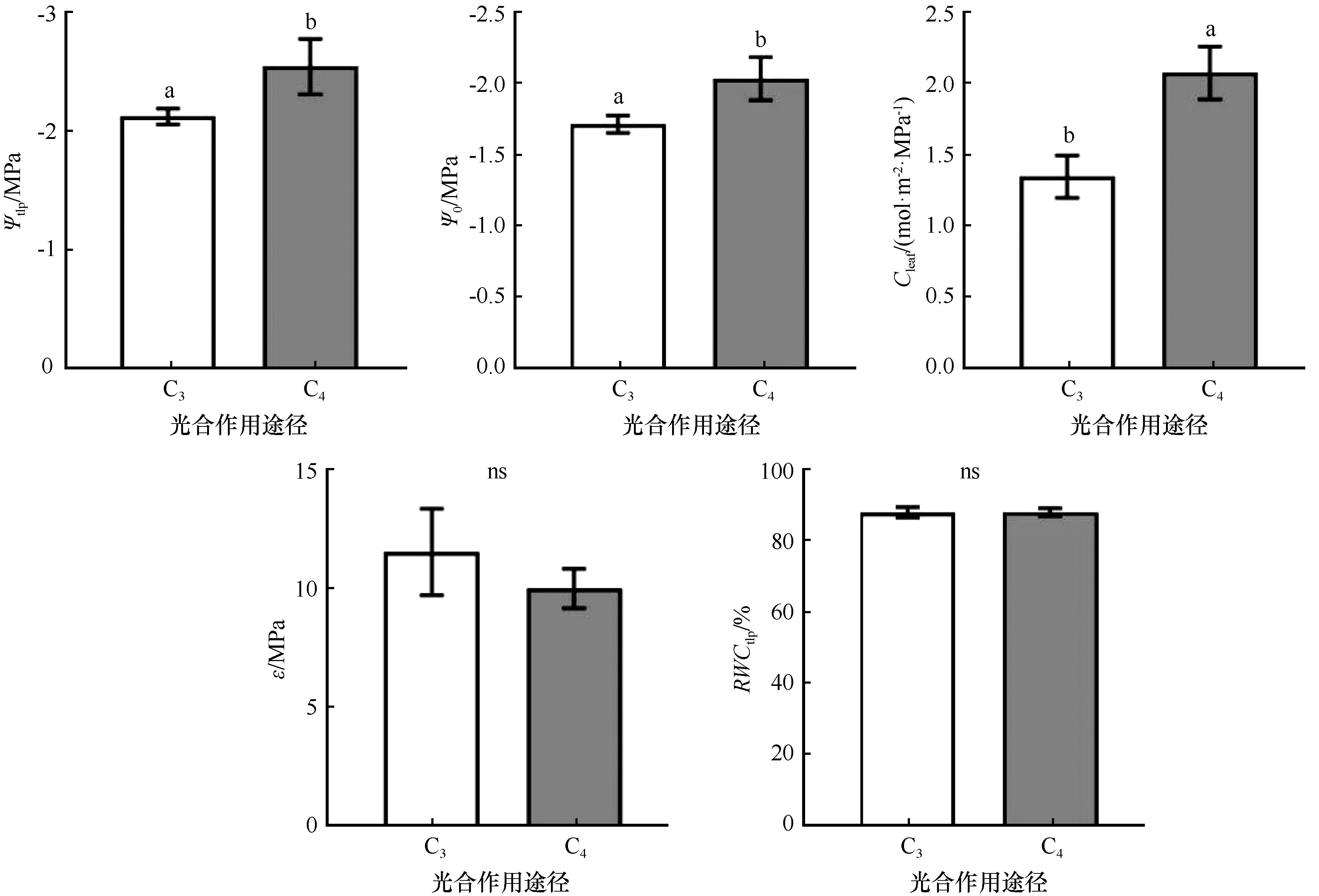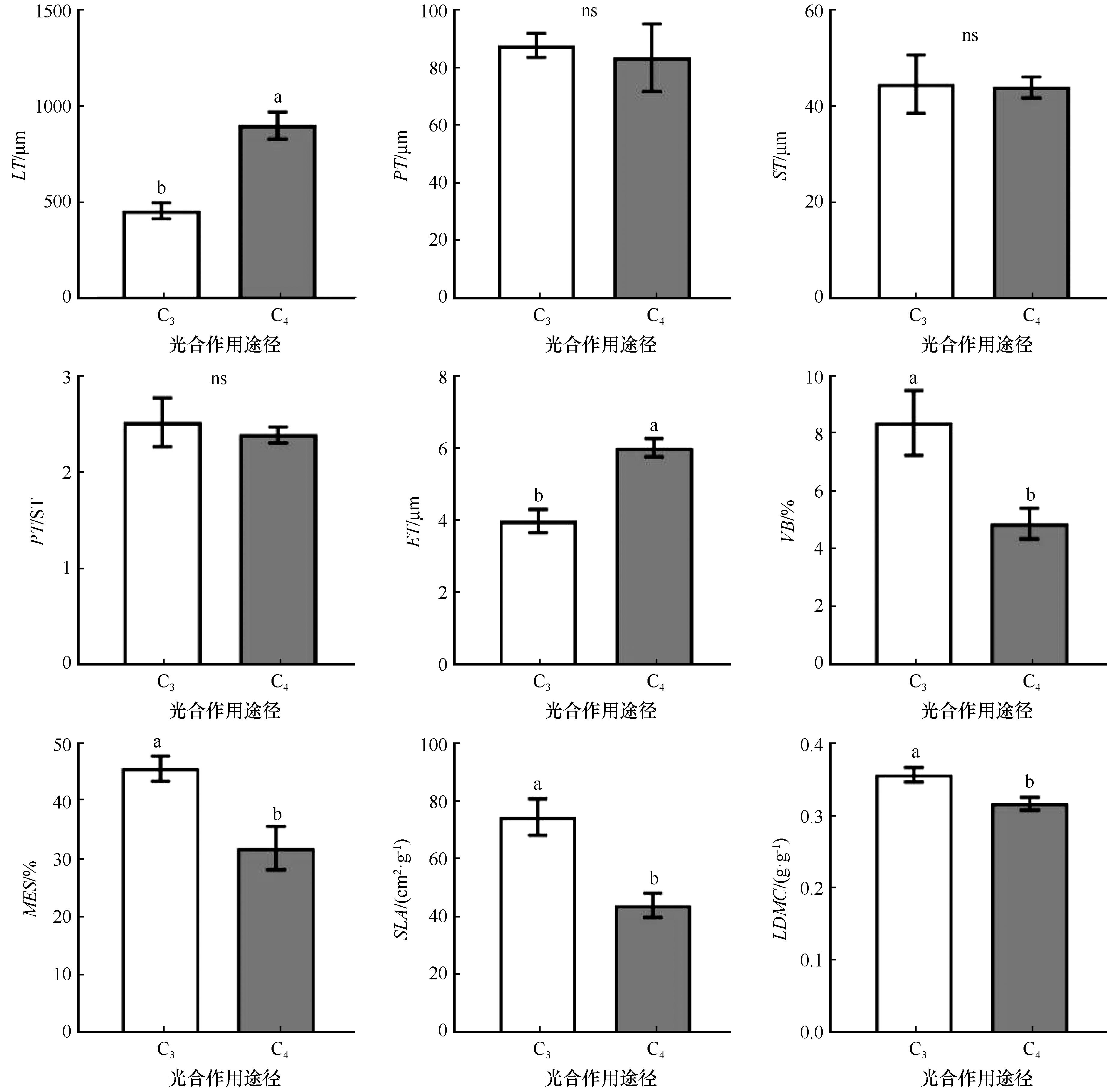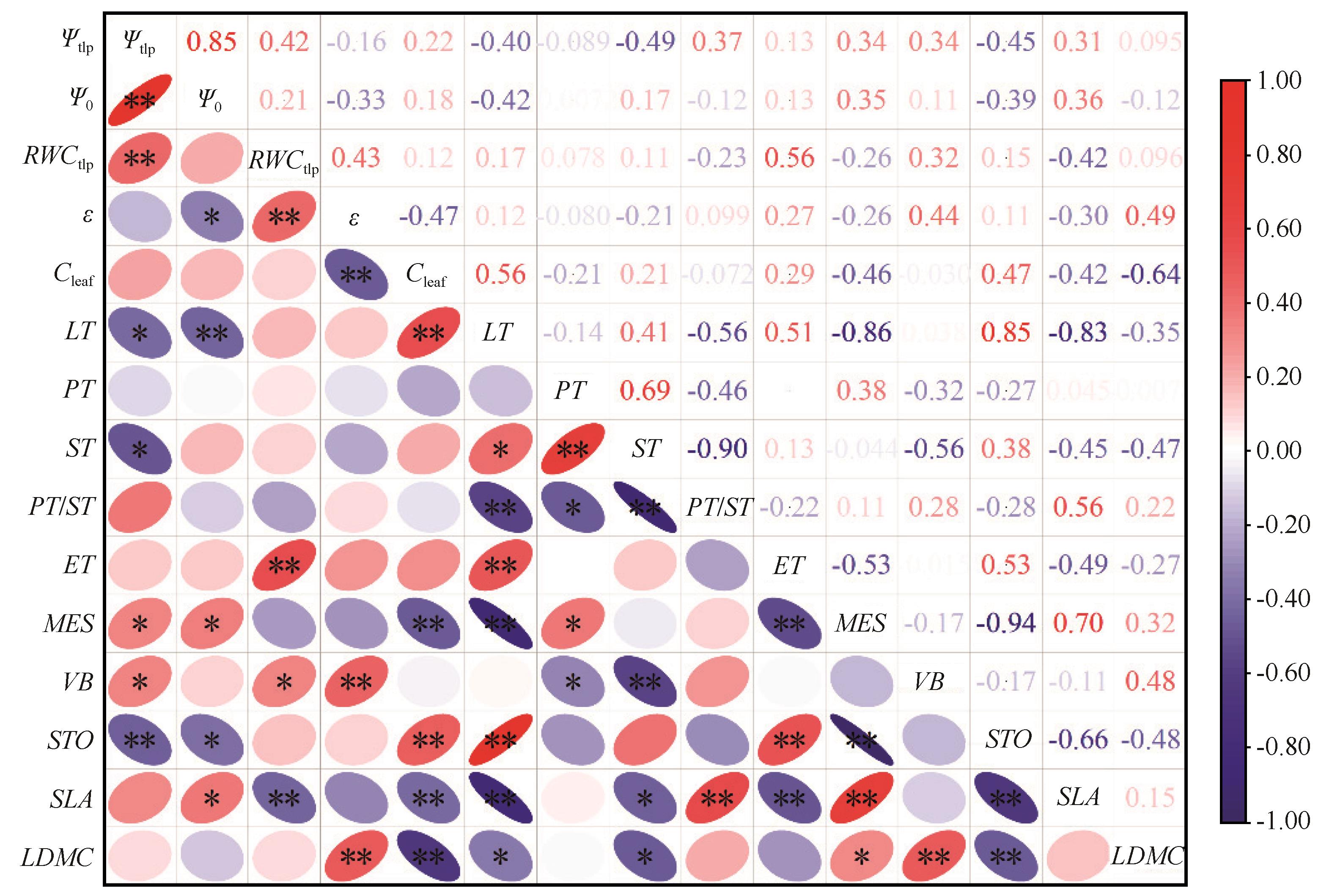
- CN 62-1070/P
- ISSN 1000-694X
- Bimonthly 1981

Journal of Desert Research ›› 2024, Vol. 44 ›› Issue (5): 205-216.DOI: 10.7522/j.issn.1000-694X.2024.00118
Previous Articles Next Articles
Ruibing Duan1,2( ), Rui Zhang2, Lele Wang2, Yaxin Zhang2, Zhan Yang1, Xue Dong1, Yingbin Ma1(
), Rui Zhang2, Lele Wang2, Yaxin Zhang2, Zhan Yang1, Xue Dong1, Yingbin Ma1( )
)
Received:2024-06-08
Revised:2024-09-04
Online:2024-09-20
Published:2024-10-15
Contact:
Yingbin Ma
CLC Number:
Ruibing Duan, Rui Zhang, Lele Wang, Yaxin Zhang, Zhan Yang, Xue Dong, Yingbin Ma. Relationship between leaf PV curve water parameters and anatomical characteristics of ten plants spieces in the Ulan Buh Desert[J]. Journal of Desert Research, 2024, 44(5): 205-216.
Add to citation manager EndNote|Ris|BibTeX
URL: http://www.desert.ac.cn/EN/10.7522/j.issn.1000-694X.2024.00118
| 树种 | 光合途径 | Ψtlp/MPa | Ψ0/MPa | Cleaf/(mol·m-2·MPa-1) | ε/MPa | RWCtlp/% |
|---|---|---|---|---|---|---|
| 白刺 | C3 | -2.45±0.11 | -1.33±0.12 | 1.28 ±0.23 | 7.51±1.36 | 85.91±1.39 |
| 沙棘 | C3 | -1.97±0.07 | -1.64±0.09 | 1.36±0. 11 | 8.65±1.46 | 86.53±1.43 |
| 霸王 | C4 | -3.39±0.16 | -2.50±0.17 | 1.43±0. 08 | 10.52±0.69 | 83.45±0.74 |
| 柽柳 | C3 | -1.98±0.03 | -1.85±0.08 | 0.61±0.11 | 27.79±5.88 | 96.93±.0.68 |
| 黑沙蒿 | C4 | -1.52±0.07 | -1.40±0.06 | 1.85±0.23 | 7.25±0.88 | 93.05±0.99 |
| 花棒 | C3 | -1.68±0.06 | -1.57±0.06 | 2.74±0.07 | 6.61±0.40 | 93.39±0.56 |
| 沙拐枣 | C4 | -1.82±0.13 | -1.57±0.07 | 3.04±0.35 | 7.99±1.27 | 88.64±1.84 |
| 梭梭 | C4 | -3.44±0.11 | -2.66±0.09 | 1.98±0.19 | 14.20±1.11 | 86.35±1.15 |
| 柠条 | C3 | -2.07±0.04 | -1.75±0.09 | 1.03±0.13 | 6.39±1.25 | 77.07±3.09 |
| 沙冬青 | C3 | -2.56±0.09 | -2.14±0.06 | 1.06±0.08 | 12.24±0.63 | 87.09±1.86 |
| 变异系数CV/% | 29.16 | 25.30 | 49.32 | 66.24 | 6.89 |
Table 1 PV traits of leaves/assimilating branches in ten woody plant species from the Ulan Buh Desert
| 树种 | 光合途径 | Ψtlp/MPa | Ψ0/MPa | Cleaf/(mol·m-2·MPa-1) | ε/MPa | RWCtlp/% |
|---|---|---|---|---|---|---|
| 白刺 | C3 | -2.45±0.11 | -1.33±0.12 | 1.28 ±0.23 | 7.51±1.36 | 85.91±1.39 |
| 沙棘 | C3 | -1.97±0.07 | -1.64±0.09 | 1.36±0. 11 | 8.65±1.46 | 86.53±1.43 |
| 霸王 | C4 | -3.39±0.16 | -2.50±0.17 | 1.43±0. 08 | 10.52±0.69 | 83.45±0.74 |
| 柽柳 | C3 | -1.98±0.03 | -1.85±0.08 | 0.61±0.11 | 27.79±5.88 | 96.93±.0.68 |
| 黑沙蒿 | C4 | -1.52±0.07 | -1.40±0.06 | 1.85±0.23 | 7.25±0.88 | 93.05±0.99 |
| 花棒 | C3 | -1.68±0.06 | -1.57±0.06 | 2.74±0.07 | 6.61±0.40 | 93.39±0.56 |
| 沙拐枣 | C4 | -1.82±0.13 | -1.57±0.07 | 3.04±0.35 | 7.99±1.27 | 88.64±1.84 |
| 梭梭 | C4 | -3.44±0.11 | -2.66±0.09 | 1.98±0.19 | 14.20±1.11 | 86.35±1.15 |
| 柠条 | C3 | -2.07±0.04 | -1.75±0.09 | 1.03±0.13 | 6.39±1.25 | 77.07±3.09 |
| 沙冬青 | C3 | -2.56±0.09 | -2.14±0.06 | 1.06±0.08 | 12.24±0.63 | 87.09±1.86 |
| 变异系数CV/% | 29.16 | 25.30 | 49.32 | 66.24 | 6.89 |
| 树种 | 叶片厚度LT/μm | 栅栏组织 厚度PT/μm | 海绵组织 厚度ST/μm | 栅栏/海绵 组织厚度 比值PT/ST | 角质层厚度ET/μm | 叶肉组织占叶肉细胞百分比MES/% | 维管束占叶肉细胞百分比VB/% | 贮水组织占叶肉细胞百分比STO/% | 比叶面积SLA/(cm2·g-1) | 叶干物质含量LDMC/(g·g-1) |
|---|---|---|---|---|---|---|---|---|---|---|
| 白刺 | 455.58±27.72 | 98.67±2.12 | 80.12±4.76 | 1.24±0.50 | 4.95±0.10 | 43.30±1.06 | 3.29±0.30 | 53.41±0.81 | 69.33± 3.80 | 0.29±0.12 |
| 沙棘 | 275.70±45.98 | 94.19±3.33 | 34.14±11.80 | 3.51±0.75 | 4.16±0.40 | 46.00±0.72 | 3.18±0.48 | 50.82±0.63 | 114.72±5.72 | 0.33±0.01 |
| 霸王 | 1006.97±26.05 | 145.50±7.69 | — | — | 5.34±0.19 | 34.30±0.39 | 4.03±1.15 | 61.68±1.52 | 45.83±1.27 | 0.33±0.01 |
| 柽柳 | 610.76±26.78 | 75.70±4.43 | 28.71±1.19 | 2.65±0.18 | 6.34±0.37 | 32.03±0.96 | 16.08±1.51 | 51.89±1.79 | 46.69±1.81 | 0.42±0.01 |
| 黑沙蒿 | 442.61±20.31 | 104.71±4.02 | 43.90±2.18 | 2.39±0.08 | 6.93±0.55 | 54.44±0.06 | 3.42±0.34 | 42.14±0.33 | 69.21±2.39 | 0.33±0.01 |
| 花棒 | 776.09±20.72 | 94.15±3.30 | — | — | 4.09±0.30 | 35.68±1.26 | 13.20±0.64 | 51.11±1.17 | 47.13±0.84 | 0.33±0.01 |
| 沙拐枣 | 1108.54±30.84 | 51.28±5.76 | — | — | 6.64±0.33 | 22.05±1.31 | 7.35±0.65 | 70.60±1.42 | 29.95±2.61 | 0.30±0.03 |
| 梭梭 | 1035.64±37.78 | 32.24±0.52 | — | — | 5.16±0.25 | 16.82±1.18 | 4.71±0.87 | 78.47±0.60 | 30.64±0.91 | 0.31±0.02 |
| 柠条 | 200.23±1.54 | 51.68±1.59 | 14.91±0.67 | 3.48±0.15 | 1.86±0.04 | 59.22±0.59 | 10.85±0.66 | 29.93±1.06 | 115.78±3.04 | 0.38±0.02 |
| 沙冬青 | 414.14±14.16 | 111.98±4.74 | 65.11±1.00 | 1.72±0.09 | 2.50±0.32 | 57.85±2.18 | 3.61±0.49 | 38.54±2.11 | 52.57±0.99 | 0.39±0.01 |
| 变异系数CV/% | 50.68 | 38.66 | 51.28 | 49.09 | 35.49 | 35.24 | 68.39 | 26.76 | 48.37 | 14.04 |
Table 2 Anatomical and structural characteristics of leaves/assimilating branches in ten woody plant species from the Ulan Buh Desert
| 树种 | 叶片厚度LT/μm | 栅栏组织 厚度PT/μm | 海绵组织 厚度ST/μm | 栅栏/海绵 组织厚度 比值PT/ST | 角质层厚度ET/μm | 叶肉组织占叶肉细胞百分比MES/% | 维管束占叶肉细胞百分比VB/% | 贮水组织占叶肉细胞百分比STO/% | 比叶面积SLA/(cm2·g-1) | 叶干物质含量LDMC/(g·g-1) |
|---|---|---|---|---|---|---|---|---|---|---|
| 白刺 | 455.58±27.72 | 98.67±2.12 | 80.12±4.76 | 1.24±0.50 | 4.95±0.10 | 43.30±1.06 | 3.29±0.30 | 53.41±0.81 | 69.33± 3.80 | 0.29±0.12 |
| 沙棘 | 275.70±45.98 | 94.19±3.33 | 34.14±11.80 | 3.51±0.75 | 4.16±0.40 | 46.00±0.72 | 3.18±0.48 | 50.82±0.63 | 114.72±5.72 | 0.33±0.01 |
| 霸王 | 1006.97±26.05 | 145.50±7.69 | — | — | 5.34±0.19 | 34.30±0.39 | 4.03±1.15 | 61.68±1.52 | 45.83±1.27 | 0.33±0.01 |
| 柽柳 | 610.76±26.78 | 75.70±4.43 | 28.71±1.19 | 2.65±0.18 | 6.34±0.37 | 32.03±0.96 | 16.08±1.51 | 51.89±1.79 | 46.69±1.81 | 0.42±0.01 |
| 黑沙蒿 | 442.61±20.31 | 104.71±4.02 | 43.90±2.18 | 2.39±0.08 | 6.93±0.55 | 54.44±0.06 | 3.42±0.34 | 42.14±0.33 | 69.21±2.39 | 0.33±0.01 |
| 花棒 | 776.09±20.72 | 94.15±3.30 | — | — | 4.09±0.30 | 35.68±1.26 | 13.20±0.64 | 51.11±1.17 | 47.13±0.84 | 0.33±0.01 |
| 沙拐枣 | 1108.54±30.84 | 51.28±5.76 | — | — | 6.64±0.33 | 22.05±1.31 | 7.35±0.65 | 70.60±1.42 | 29.95±2.61 | 0.30±0.03 |
| 梭梭 | 1035.64±37.78 | 32.24±0.52 | — | — | 5.16±0.25 | 16.82±1.18 | 4.71±0.87 | 78.47±0.60 | 30.64±0.91 | 0.31±0.02 |
| 柠条 | 200.23±1.54 | 51.68±1.59 | 14.91±0.67 | 3.48±0.15 | 1.86±0.04 | 59.22±0.59 | 10.85±0.66 | 29.93±1.06 | 115.78±3.04 | 0.38±0.02 |
| 沙冬青 | 414.14±14.16 | 111.98±4.74 | 65.11±1.00 | 1.72±0.09 | 2.50±0.32 | 57.85±2.18 | 3.61±0.49 | 38.54±2.11 | 52.57±0.99 | 0.39±0.01 |
| 变异系数CV/% | 50.68 | 38.66 | 51.28 | 49.09 | 35.49 | 35.24 | 68.39 | 26.76 | 48.37 | 14.04 |

Fig.1 Comparison of PV traits in plants with different photosynthetic pathways from the Ulan Buh Desert (mean ± SE)Note: different lowercase letters indicate significant differences among plant species (P< 0.05) , ns, not significant

Fig.2 Comparison of leaf structure and anatomical characteristics in plants with different photosynthetic pathways from the Ulan Buh Desert. Note: different lowercase letters indicate significant differences among plant species (P< 0.05) ,ns, not significant

Fig.6 Correlation analysis of PV traits and anatomical and structural characteristics of leaves/assimilating branches in ten woody plant species from the Ulan Buh Desert. Note: *, P<0.05;**, P<0.01
| 1 | Li X R, Xiao H L, Zhang J G,et al.Long‐term ecosystem effects of sand‐binding vegetation in the Tengger Desert,northern China[J].Restoration Ecology,2004,12(3):376-390. |
| 2 | Chu X, Zhan J, Li Z,et al.Assessment on forest carbon sequestration in the Three-North Shelterbelt Program region,China[J].Journal of Cleaner Production,2019,215:382-389. |
| 3 | Zhang D, Zuo X, Zang C.Assessment of future potential carbon sequestration and water consumption in the construction area of the Three-North Shelterbelt Programme in China[J].Agricultural and Forest Meteorology,2021,303:108377. |
| 4 | Bai Y, Zhang Y, Michalet R,et al.Responses of different herb life-history groups to a dominant shrub species along a dune stabilization gradient[J].Basic and Applied Ecology,2019,38:1-12. |
| 5 | McDowell N G, Allen C D.Darcy's law predicts widespread forest mortality under climate warming[J].Nature Climate Change,2015,5(7):669-672. |
| 6 | Yu T, Liu P, Zhang Q,et al.Detecting forest degradation in the three-north forest shelterbelt in China from multi-scale satellite images[J].Remote Sensing,2021,13(6):1131. |
| 7 | 杨柳,孙慧珍.植物水分生理研究中的压力-容积测定技术几个关键问题[J].生态学杂志,2014,33(1):229-234. |
| 8 | 吴建慧,郭瑶,赵倩竹,等.干旱胁迫对绢毛委陵菜叶片解剖结构和生理指标的影响[J].草业科学,2012,29(8):1229-1234. |
| 9 | 李瑞强,王玉祥,孙玉兰,等.盐胁迫对无芒雀麦幼苗叶片形态及解剖结构的影响[J].草地学报,2022,30(6):1450-1459. |
| 10 | Ehleringer J R, Cerling T E.C3 and C4 photosynthesis[J].Encyclopedia of Global Environmental Change,2002,2(4):186-190. |
| 11 | Brodribb T, Holbrook N M, Gutierrez M.Hydraulic and photosynthetic co-ordination in seasonally dry tropical forest trees[J].Plant,Cell and Environment,2002,25(11):1435-1444. |
| 12 | Kocacinar F, Mckown A D, Sage T L,et al.Photosynthetic pathway influences xylem structure and function in Flaveria (Asteraceae)[J].Plant,Cell and Environment,2008,31(10):1363-1376. |
| 13 | Liu H, Taylor S H, Xu Q,et al.Life history is a key factor explaining functional trait diversity among subtropical grasses,and its influence differs between C3 and C4 species[J].Journal of Experimental Botany,2019,70(5):1567-1580. |
| 14 | 种培芳,李航逸,李毅.荒漠植物红砂根系对干旱胁迫的生理响应[J].草业学报,2015,24(1):72-80. |
| 15 | 徐梦琦,高艳菊,张志浩,等.干旱胁迫对疏叶骆驼刺幼苗生长和生理的影响[J].干旱区研究,2023,40(2):257-267. |
| 16 | Hinckley T, Duhme F, Hinckley A,et al.Water relations of drought hardy shrubs:osmotic potential and stomatal reactivity[J].Plant,Cell and Environment,1980,3(2):131-140. |
| 17 | Turner N C.Measurement of plant water status by the pressure chamber technique[J].Irrigation Science,1988,9(4):289-308. |
| 18 | Meinzer F C, Woodruff D R, Marias D E,et al.Dynamics of leaf water relations components in co-occurring iso-and anisohydric conifer species[J].Plant,Cell and Environment,2014,37(11):2577-2586. |
| 19 | Tyree M T, Hammel H T.The measurement of the turgor pressure and the water relations of plants by the pressure-bomb technique[J].Journal of Experimental Botany,1972,23(1):267-282. |
| 20 | Bartlett M K, Scoffoni C, Sack L.The determinants of leaf turgor loss point and prediction of drought tolerance of species and biomes:a global meta‐analysis[J].Ecology Letters,2012,15(5):393-405. |
| 21 | 王万里.压力室 (PRESSURE CHAMBER) 在植物水分状况研究中的应用[J].植物生理学通讯,1984,3:52-57. |
| 22 | 李吉跃.PV技术在油松侧柏苗木抗旱特性研究中的应用[J].北京林业大学学报,1989,11(1):3-11. |
| 23 | 李向义,张希明,何兴元,等.沙漠-绿洲过渡带四种多年生植物水分关系特征[J].生态学报,2004,24(6):1164-1171. |
| 24 | Bartlett M K, Zhang Y, Kreidler N,et al.Global analysis of plasticity in turgor loss point,a key drought tolerance trait[J].Ecology Letters,2014,17(12):1580-1590. |
| 25 | Zhu S D, Chen Y J, Ye Q,et al.Leaf turgor loss point is correlated with drought tolerance and leaf carbon economics traits[J].Tree Physiology,2018,38(5):658-663. |
| 26 | Blackman C J.Leaf turgor loss as a predictor of plant drought response strategies[J].Tree Physiology,2018,38(5):655-657. |
| 27 | 斯琴巴特尔,秀敏.荒漠植物蒙古扁桃水分生理特征[J].植物生态学报,2007,31(3):484-489. |
| 28 | 王乐乐,周正虎,金鹰,等.东北温带森林20 种乔木树种叶片干旱容忍性特征[J].应用生态学报,2022,33(1):1-8. |
| 29 | Rosas T, Mencuccini M, Barba J,et al.Adjustments and coordination of hydraulic,leaf and stem traits along a water availability gradient[J].New Phytologist,2019,223(2):632-646. |
| 30 | Xu H, Li Y, Xu G,et al.Ecophysiological response and morphological adjustment of two Central Asian desert shrubs towards variation in summer precipitation[J].Plant,Cell and Environment,2007,30(4):399-409. |
| 31 | 石松利,王迎春,周红兵,等.濒危种四合木与其近缘种霸王水分关系参数和光合特性的比较[J].生态学报,32(4):1163-1173. |
| 32 | 李芳兰,包维楷.植物叶片形态解剖结构对环境变化的响应与适应[J].植物学报,2005,22():118-127. |
| 33 | 庞杰,张凤兰,郝丽珍,等.沙芥幼苗叶片解剖结构和光合作用对干旱胁迫的响应[J].生态环境学报,2013,22(4):575-581. |
| 34 | 黄振英,吴鸿,胡正海.30种新疆沙生植物的结构及其对沙漠环境的适应[J].植物生态学报,1997,21(6):521-530. |
| 35 | 刘玉冰,李新荣,李蒙蒙,等.中国干旱半干旱区荒漠植物叶片 (或同化枝) 表皮微形态特征[J].植物生态学报,2016,40(11):1189. |
| 36 | Feng X, Liu R, Li C,et al.Multi-level physiological and morphological adjustment of haloxylon ammodendron related to groundwater drawdown in a desert ecosystem[J].Agricultural and Forest Meteorology,2022,324:109096. |
| 37 | Zhang K Y, Yang D, Zhang Y B,et al.Differentiation in stem and leaf traits among sympatric lianas,scandent shrubs and trees in a subalpine cold temperate forest[J].Tree Physiology,2021,41(11):1992-2003. |
| 38 | 张海娜,苏培玺,李善家,等.荒漠区植物光合器官解剖结构对水分利用效率的指示作用[J].生态学报,2013,33(16):4909-4918. |
| 39 | Ivanova L A, Yudina P K, Ronzhina D A,et al.Quantitative mesophyll parameters rather than whole-leaf traits predict response of C3 steppe plants to aridity[J].New Phytologist,2018,217(2):558-570. |
| 40 | 李爱平,王晓江,杨小玉,等.库布齐沙漠几种沙生灌木叶解剖结构耐旱特征研究[J].中国沙漠,2010,30(6):1405-1410. |
| 41 | 杨树德,陈国仓,张承烈,等.胡杨披针形叶与宽卵形叶的渗透调节能力的差异[J].西北植物学报,2004(9):1583-1588. |
| 42 | 杨戈,王常贵.罗布泊地区几种旱生植物茎、叶结构的初步研究[J].干旱区研究,1984,57(1):57-63. |
| 43 | 昝丹丹,庄丽,黄刚,等.不同梭梭种群同化枝的解剖结构特征及其与生态因子的关系分析[J].西北植物学报,2016,36(2):309-315. |
| 44 | 刘莉,任昱.几种沙生植物水分代谢问题探讨[J].内蒙古林业科技,2011,37(3):8-12. |
| 45 | 龚春梅,宁蓬勃,王根轩,等.C3和C4植物光合途径的适应性变化和进化[J].植物生态学报,2009,33(1):206-221. |
| 46 | Jacob V, Choat B, Churchill A C,et al.High safety margins to drought‐induced hydraulic failure found in five pasture grasses[J].Plant,Cell and Environment,2022,45(6):1631-1646. |
| 47 | Ogburn R M, Edwards E J.Quantifying succulence:a rapid,physiologically meaningful metric of plant water storage[J].Plant,Cell and Environment,2012,35(9):1533-1542. |
| 48 | 闫海龙,张希明,许浩,等.塔里木沙漠公路防护林植物沙拐枣气体交换特性对干旱胁迫的响应[J].中国沙漠,2007,27(3):460-465. |
| 49 | Niinemets Ü.Global‐scale climatic controls of leaf dry mass per area,density,and thickness in trees and shrubs[J].Ecology,2001,82(2):453-469. |
| 50 | Liu C, Li Y, Xu L,et al.Variation in leaf morphological,stomatal,and anatomical traits and their relationships in temperate and subtropical forests[J].Scientific Reports,2019,9(1):5803. |
| 51 | Moore P D.High hopes for C4 plants[J].Nature,1994,367(6461):322-323. |
| 52 | Akram M A, Zhang Y, Wang X,et al.Phylogenetic independence in the variations in leaf functional traits among different plant life forms in an arid environment[J].Journal of Plant Physiology,2022,272:153671. |
| 53 | Sack L, Scoffoni C, John G P,et al.How do leaf veins influence the worldwide leaf economic spectrum?Review and synthesis[J].Journal of Experimental Botany,2013,64(13):4053-4080. |
| 54 | Wright I J, Reich P B, Cornelissen J H,et al.Assessing the generality of global leaf trait relationships[J].New Phytologist,2005,166(2):485-496. |
| 55 | Nguyen H T, Meir P, Sack L,et al.Leaf water storage increases with salinity and aridity in the mangrove Avicennia marina:integration of leaf structure,osmotic adjustment and access to multiple water sources[J].Plant,Cell and Environment,2017,40(8):1576-1591. |
| 56 | Nguyen H T, Meir P, Wolfe J,et al.Plumbing the depths:extracellular water storage in specialized leaf structures and its functional expression in a three‐domain pressure-volume relationship[J].Plant,Cell and Environment,2017,40(7):1021-1038. |
| [1] | Jin Fang, Rentao Liu, Xuan Zhao, Min Yang. Responses of soil meso- and micro-fauna diversity and functional groups to soil texture of oasis farmland in arid region [J]. Journal of Desert Research, 2024, 44(6): 155-166. |
| [2] | Jiannan Lu, Yuqiang Li, Xueyong Zhao, Baocheng Li, Xuyang Wang, Rui Zhang. Characteristics of ecological environment changes and advices for combating desertification in typical semi-arid sandy land [J]. Journal of Desert Research, 2024, 44(4): 284-292. |
| [3] | Teng Zhang, Yunfa Miao, Yaguo Zou, Ziyue Zhang, Guoping Feng. Classification and changes of vegetation in Sugan Lake wetland in the extreme arid region [J]. Journal of Desert Research, 2024, 44(4): 81-90. |
| [4] | Yuxi Wei, Lijuan Chen, Qi Feng, Haiyang Xi, Rui Guo, Chengqi Zhang. Progress on microbial characteristics in arid salt-affected soils and related factors [J]. Journal of Desert Research, 2024, 44(3): 18-30. |
| [5] | Changxiang Pan, Qianru Ouyang, Mengyu Liao, Yu Fan, Qun Guo, Zhishan Zhang, Genan Wu, Yang Zhao, Lichao Liu, Yanxia Pan, Xinrong Li, Jianjun Qu, Songlin Mu, Shenggong Li. The applicability of ecological restoration technologies and sand industries to the deserted land in northwest arid region of China [J]. Journal of Desert Research, 2023, 43(5): 155-165. |
| [6] | Shanling Cheng, Haipeng Yu, Yu Ren, Jie Zhou, Hongyu Luo, Chenxi Liu, Yongqi Gong. Research progress on the influence mechanism of climate anomalies in arid and semi-arid regions in China [J]. Journal of Desert Research, 2023, 43(3): 21-35. |
| [7] | Lin Li, Hu Liu, Chengpeng Sun, Wenzhi Zhao. Groundwater evapotranspiration estimation based on soil moisture and water table measurements [J]. Journal of Desert Research, 2022, 42(6): 277-287. |
| [8] | Yanbin Hu, Qiang Zhang, Guoju Xiao, Zhengji Qiu, Yongping Li, Zhanqiang Guo. Effect of soil carbon, nitrgen and phosphate contents on maize production in semi-arid regions of China [J]. Journal of Desert Research, 2022, 42(3): 261-273. |
| [9] | Tianyan Su, Zihan Liu, Anqi Cong, Wei Mao, Qiu Yang. Effects of groundwater depth on soil enzymatic activities of typical plant communities in semi-arid area [J]. Journal of Desert Research, 2021, 41(4): 185-194. |
| [10] | Hei Weigao, Zhan Jin, Han Dan, Yang Hongling, Li Yulin. Compatible Biomass Models for Two Dominant Sand-fixing Shrubs in Horqin Sandy Land [J]. Journal of Desert Research, 2019, 39(5): 193-199. |
| [11] | Yang Ke, Meng Yaxiong, Ma Xiaole, Li Baochun, Si Erjing, Wang Juncheng, Ren Panrong, Wang Huajun. Analysis of Relationship between Variations Characteristics of Main Agronomic Traits and Quality in Hops [J]. Journal of Desert Research, 2018, 38(4): 772-779. |
| [12] | Wang Tingting, Feng Qi, Wen Xiaohu, Guo Xiaoyan. Numerical Simulation of Evaporation of Arid Region Based on Extreme Learning Machine [J]. JOURNAL OF DESERT RESEARCH, 2017, 37(6): 1219-1226. |
| [13] | Song Jie, Chunxi, Bai Xuemei, Siqin·Bilige. Review of Grain Size Analysis in China Desert [J]. JOURNAL OF DESERT RESEARCH, 2016, 36(3): 597-603. |
| [14] | Liang Xiaoyan, Wang Naiang, Li Zhuolun, Chang Peijing, Jia Peng, Niu Zhenmin. Climate Change around the Tengger Desert in 1960-2012 [J]. JOURNAL OF DESERT RESEARCH, 2016, 36(2): 474-482. |
| [15] | Zhou Xin, Zuo Xiaoan, Zhao Xueyong, Liu Chuan, Lv Peng. Plant Functional Traits and Interrelationships of 34 Plant Species in South Central Horqin Sandy Land, China [J]. JOURNAL OF DESERT RESEARCH, 2015, 35(6): 1489-1495. |
| Viewed | ||||||
|
Full text |
|
|||||
|
Abstract |
|
|||||
©2018Journal of Desert Research
Tel:0931-8267545
Email:caiedit@lzb.ac.cn;desert@lzb.ac.cn
Support:Magtech